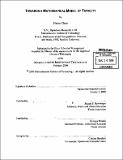Towards a mathematical model of tonality
Author(s)
Chew, Elaine, 1970-
DownloadFull printable version (9.903Mb)
Other Contributors
Sloan School of Management.
Advisor
Jeanne S. Bamberger.
Terms of use
Metadata
Show full item recordAbstract
This dissertation addresses the question of how musical pitches generate a tonal center. Being able to characterize the relationships that generate a tonal center is crucial to the computer analysis and the generating of western tonal music. It also can inform issues of compositional styles, structural boundaries, and performance decisions. The proposed Spiral Array model offers a parsimonious description of the inter-relations among tonal elements, and suggests new ways to re-conceptualize and reorganize musical information. The Spiral Array generates representations for pitches, intervals, chords and keys within a single spatial framework, allowing comparisons among elements from different hierarchical levels. Structurally, this spatial representation is a helical realization of the harmonic network (tonnetz). The basic idea behind the Spiral Array is the representation of higher level tonal elements as composites of their lower level parts. The Spiral Array assigns greatest prominence to perfect fifth and major /minor third interval relations, placing elements related by these intervals in proximity to each other. As a result, distances between tonal entities as represented spatially in the model correspond to perceived distances among sounding entities. The parameter values that affect proximity relations are prescribed based on a few perceived relations among pitches, intervals, chords and keys. This process of interfacing between the model and actual perception creates the opportunity to research some basic, but till now unanswered questions about the relationships that generate tonality. A generative model, the Spiral Array case; provides a framework on which to design viable and efficient algorithms for problems in music cognition. I demonstrate its versatility by applying the model to three different problems: I develop an algorithm to determine the key of musical passages that, on average, performs better than existing ones when applied to the 24 fugue subjects in Book I of Bach's WTC; I propose the first computationally viable method for determining modulations (the change of key); and, I design a basic algorithm for finding the roots of chords, comparing its results to those of algorithms by other researchers. All three algorithms were implemented in Matlab.
Description
Thesis (Ph.D.)--Massachusetts Institute of Technology, Sloan School of Management, 2000. Includes bibliographical references (p. 163-166).
Date issued
2000Department
Sloan School of ManagementPublisher
Massachusetts Institute of Technology
Keywords
Sloan School of Management.